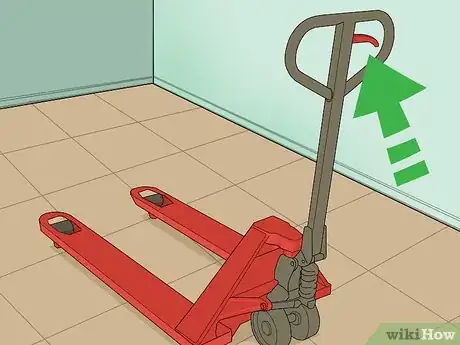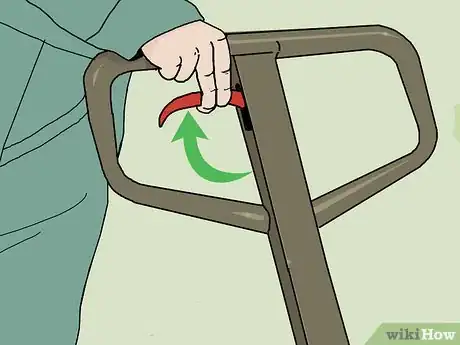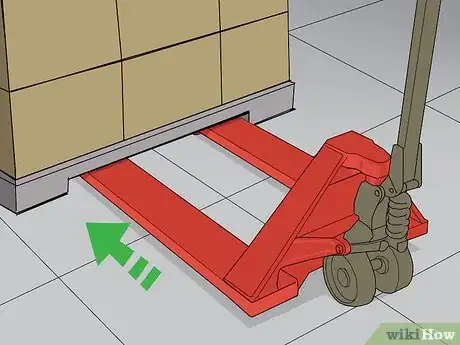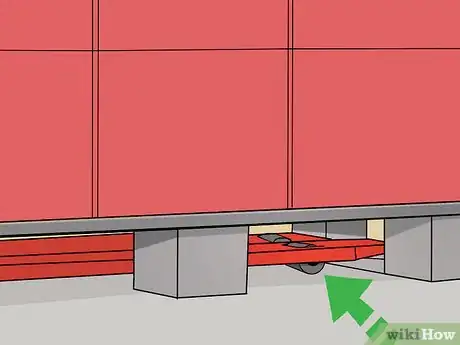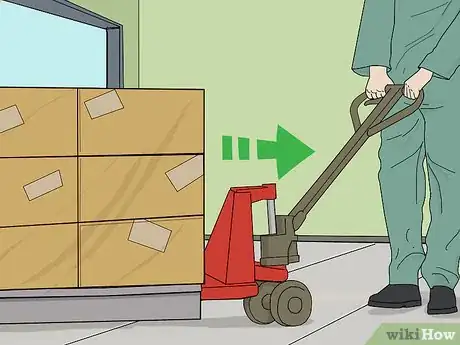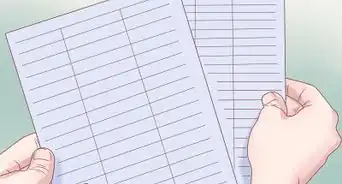This article was co-authored by wikiHow staff writer, Christopher M. Osborne, PhD. Christopher Osborne has been a wikiHow Content Creator since 2015. He is also a historian who holds a PhD from The University of Notre Dame and has taught at universities in and around Pittsburgh, PA. His scholarly publications and presentations focus on his research interests in early American history, but Chris also enjoys the challenges and rewards of writing wikiHow articles on a wide range of subjects.
This article has been viewed 177,548 times.
Learn more...
More than a few warehouse workers and other people who need to move goods have found themselves confused with one of the simpler staples of an industrial environment: the hand or manual pallet jack. Pallet jacks are built to effectively transport the rough wooden platforms know as pallets or skids that so often contain all of the goods arriving from a truck at a warehouse or retail facility. Some simple steps will help a newbie sort through the challenges of how to operate a manual pallet jack well.
Steps
-
1Find the release lever. Stand behind the manual pallet jack as this is the position you will be in when you move it. Find the small lever that allows the pallet jack prongs (the large flat metal pieces near the floor) to drop all the way down toward the floor.[1]
- The pallet jack drop lever is often a small lever in the middle of the rounded handle, on the vertical stem of the manual machine. It may be distinguished by a different color of plastic, or otherwise marked, or it may not be.
-
2Push inward on the drop lever to lower the prongs. If the prongs are already completely lowered, you will not see them move. The prongs should only be an inch or two from the floor.[2]Advertisement
-
3Put the prongs underneath the skid or pallet. You will see when approaching the skid whether or not the product will fit underneath.[3] If they will not fit, the machine has not been lowered sufficiently, so try to push again on the drop lever.
-
4Use the handle to jack up the pallet jack. When the prongs are under the skid, pull the vertical stem toward you, away from the pallet and toward the floor in a diagonal motion. You should feel the pallet jack (and the pallet) slowly rising against the pressure of gravity.[4]
-
5Check to make sure that the pallet jack is not on the cross wood of the skid, front wheels must be on the floor. If the wheels are on the cross wood this will stop the jack from going up and also stop it from rolling.
- Make sure that the pallet is jacked up from the floor before moving the manual pallet jack.
-
6Move the pallet jack. When it looks and feels like the pallet is sufficiently raised so that it will not drag, pull on the pallet jack handle to move the raised pallet in any one direction. Alternately, users can push against the pallet when it's time to move the pallet up over a lift gate or onto a truck.[5]
Community Q&A
-
QuestionDoes it have a brake for stopping when the pallet jack is full?
 Community AnswerVery few are fitted with a brake. The easiest way to stop a potential runaway is to quickly squeeze the handle and drop the pallet to the floor.
Community AnswerVery few are fitted with a brake. The easiest way to stop a potential runaway is to quickly squeeze the handle and drop the pallet to the floor. -
QuestionI ordered a pallet truck of 3t capacity. The effort to pull 2000 kgs is not possible by a single person, so what is the solution if we need to move the load by a single person?
 Mzm555Top AnswererIt depends on the weight distribution of the load, the quality of the pallet jack, and the floor surface (particularly how smooth it is) with a good quality pallet jack, stable load, and flat, very smooth concrete. A 2000kg load can be sufficiently moved with some effort; however, with poor ground, a poor quality pallet jack, unstable loads, slopes, etc., it will be much more difficult for the pallet jack worker. For loads exceeding 2500kg, a motorized pallet jack, "walkie stacker" or Forklift is recommended.
Mzm555Top AnswererIt depends on the weight distribution of the load, the quality of the pallet jack, and the floor surface (particularly how smooth it is) with a good quality pallet jack, stable load, and flat, very smooth concrete. A 2000kg load can be sufficiently moved with some effort; however, with poor ground, a poor quality pallet jack, unstable loads, slopes, etc., it will be much more difficult for the pallet jack worker. For loads exceeding 2500kg, a motorized pallet jack, "walkie stacker" or Forklift is recommended. -
QuestionWhat is the difference between a battery operated pallet truck and an electric pallet truck?
 Community AnswerThere is no difference, it's just a different name.
Community AnswerThere is no difference, it's just a different name.
Warnings
- Wear appropriate footwear. A wrong turn with a manual pallet jack can cause contact with your feet. Many industrial jobs require steel toed boots to protect the worker against harm. In any case, don't try to operate a manual pallet jack wearing heels or other footwear that can cause the operator to walk in a less stable way. By the same token, make sure not to wear any long flowing clothes that can get caught in the machine.⧼thumbs_response⧽
